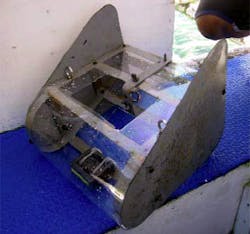System stitches images of underwater reefs
Researchers from the Mapua Insitute of Technology (Manila, Philippines) and the National Institute of Physics (Quezon City, Philippines) have developed a system that can make fast and frequent surveys of shallow reefs.
Their so-called "Teardrop" system consists of a towable teardrop shaped finned hull, an off-the-shelf underwater camera, a GPS logger and software that can stitch the image captured by the camera together.
To use the system, researchers simply need to tie it to the side of a boat, turn on the video mode of the underwater camera, lower it into the water and tow it around the coastal region of interest.
Captured video is parsed into image frames and stitched together to form a mosaic of a coral reef either using either Microsoft's Image Composite Editor (ICE) or Bath University's (Bath, UK) Autostitch.
The researchers say that the low cost of the system (at around $350) should make it appealing to those involved in protecting coastal resources.
The researchers presented details of the system at the 12th International Coral Reef Symposium (Cairns, Australia) in July. A copy of their presentation can be found here.
Interested in reading more about imaging technologies used at sea? Here's a compendium of three of the top stories on the subject that Vision Systems Design has published over the past year.
1. Camera captures polarized view of the ocean
A team of researchers at the University of Bristol (Bristol, UK) has developed a specialized camera that allows scientists to "see" polarized light, just as reef-dwelling animals do.
2. Underwater sled helps fishermen image the sea
An underwater video camera system has been trialed by Seafish (Edinburgh, UK) to determine whether fishermen can monitor environmental conditions in marine protected areas (MPAs).
3. Sonar and radar monitor effect of tidal turbine
A team of UK scientists are using sonar and radar to measure the environmental effects of tidal and wave energy devices by monitoring the environment and wildlife behavior at UK test sites, the first of which is the tidal energy test area of the European Marine Energy Centre in Orkney.
-- Dave Wilson, Senior Editor, Vision Systems Design
